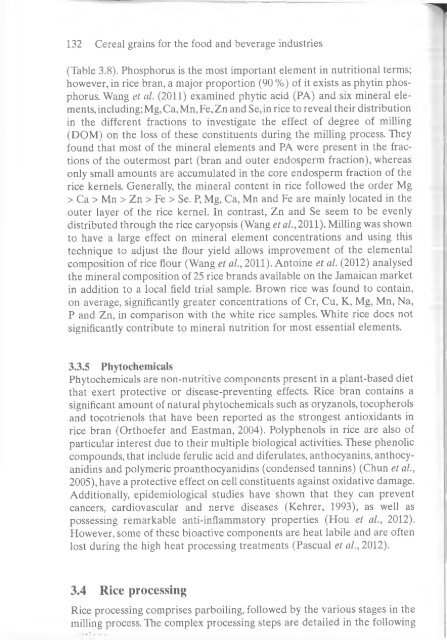Arendt und Zannini - 2013 - Cereal grains for the food and beverage industries
Arendt und Zannini - 2013 - Cereal grains for the food and beverage industries
Arendt und Zannini - 2013 - Cereal grains for the food and beverage industries
Create successful ePaper yourself
Turn your PDF publications into a flip-book with our unique Google optimized e-Paper software.
132 <strong>Cereal</strong> <strong>grains</strong> <strong>for</strong> <strong>the</strong> <strong>food</strong> <strong>and</strong> <strong>beverage</strong> <strong>industries</strong><br />
(Table 3.8). Phosphorus is <strong>the</strong> most important element in nutritional terms;<br />
however, in rice bran, a major proportion (90 %) of it exists as phytin phosphorus.<br />
Wang et al. (2011) examined phytic acid (PA) <strong>and</strong> six mineral elements,<br />
including; Mg, Ca, Mn, Fe, Zn <strong>and</strong> Se, in rice to reveal <strong>the</strong>ir distribution<br />
in <strong>the</strong> different fractions to investigate <strong>the</strong> effect of degree of milling<br />
(DOM) on <strong>the</strong> loss of <strong>the</strong>se constituents during <strong>the</strong> milling process. They<br />
fo<strong>und</strong> that most of <strong>the</strong> mineral elements <strong>and</strong> PA were present in <strong>the</strong> fractions<br />
of <strong>the</strong> outermost part (bran <strong>and</strong> outer endosperm fraction), whereas<br />
only small amounts are accumulated in <strong>the</strong> core endosperm fraction of <strong>the</strong><br />
rice kernels. Generally, <strong>the</strong> mineral content in rice followed <strong>the</strong> order Mg<br />
> Ca > Mn > Zn > Fe > Se. P, Mg, Ca, Mn <strong>and</strong> Fe are mainly located in <strong>the</strong><br />
outer layer of <strong>the</strong> rice kernel. In contrast, Zn <strong>and</strong> Se seem to be evenly<br />
distributed through <strong>the</strong> rice caryopsis (Wang et«/., 2011). Milling was shown<br />
to have a large effect on mineral element concentrations <strong>and</strong> using this<br />
technique to adjust <strong>the</strong> flour yield allows improvement of <strong>the</strong> elemental<br />
composition of rice flour (Wang et al., 2011). Antoine et al. (2012) analysed<br />
<strong>the</strong> mineral composition of 25 rice br<strong>and</strong>s available on <strong>the</strong> Jamaican market<br />
in addition to a local field trial sample. Brown rice was fo<strong>und</strong> to contain,<br />
on average, significantly greater concentrations of Cr, Cu, K, Mg, Mn, Na,<br />
P <strong>and</strong> Zn, in comparison with <strong>the</strong> white rice samples. White rice does not<br />
significantly contribute to mineral nutrition <strong>for</strong> most essential elements.<br />
3.3.5 Phytochemicals<br />
Phytochemicals are non-nutritive components present in a plant-based diet<br />
that exert protective or disease-preventing effects. Rice bran contains a<br />
significant amount of natural phytochemicals such as oryzanols, tocopherols<br />
<strong>and</strong> tocotrienols that have been reported as <strong>the</strong> strongest antioxidants in<br />
rice bran (Orthoefer <strong>and</strong> Eastman, 2004). Polyphenols in rice are also of<br />
particular interest due to <strong>the</strong>ir multiple biological activities. These phenolic<br />
compo<strong>und</strong>s, that include ferulic acid <strong>and</strong> diferulates, anthocyanins, anthocyanidins<br />
<strong>and</strong> polymeric proanthocyanidins (condensed tannins) (Chun et al.,<br />
2005), have a protective effect on cell constituents against oxidative damage.<br />
Additionally, epidemiological studies have shown that <strong>the</strong>y can prevent<br />
cancers, cardiovascular <strong>and</strong> nerve diseases (Kehrer, 1993), as well as<br />
possessing remarkable anti-inflammatory properties (Hou et al., 2012).<br />
However, some of <strong>the</strong>se bioactive components are heat labile <strong>and</strong> are often<br />
lost during <strong>the</strong> high heat processing treatments (Pascual et al., 2012).<br />
3.4 Rice processing<br />
Rice processing comprises parboiling, followed by <strong>the</strong> various stages in <strong>the</strong><br />
milling process. The complex processing steps are detailed in <strong>the</strong> following

















